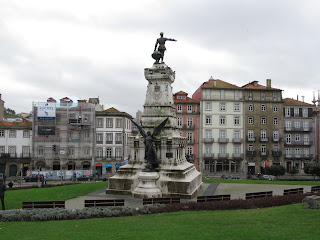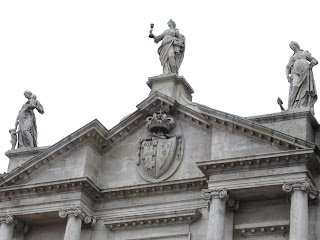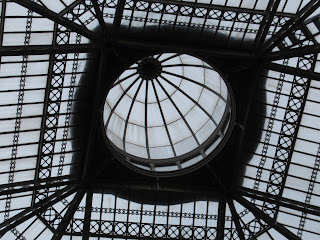Over two months ago I returned from being away on vacation with a friend in New Zealand and Australia for 3.5 weeks. In case you also want to follow that really fun trip Down Under, here's a link to the newest blog: www.bergersadventures7.blogspot.com
Just down the traffic-free street from our apartment in central Porto was the elaborate, skinny facade of Misericordia Church. It was also a Chapter House which meant it was a residence for priests and monks. The church was built in the second half of the 16th century but underwent many changes 200 years later because of work done by famed Italian architect Nicolau Nasoni who made his mark in Porto.
As part of its Works of Mercy, Misericordia managed hospitals for over 500 years and had an important role providing health services in northern Portugal. The involvement of the church in health care, medical education and humanitarian and social programs was, and still is, critical.
Among the church priorities were taking care of poor prisoners who had no means to defend themselves and no resources for treatment if they ended up in the prison wards. The Misericordia provided them with food and legal support, hiring lawyers to defend them and doctors and surgeons to administer to their health. The Commitment of 1594 ordered that two men responsible for the jails were elected to reflect their humanitarian role.
The church and its foundation established educational institutions, provided assistance and shelter.
The act of giving by benefactors was a deeply religious act which aimed to reaffirm faith. By saving the souls of others, the benefactor was also saving his or her own. The act of giving expressed compassion for those in need which ensured eternal redemption. After the death of the benefactors, arrangements were made to make portraits to perpetuate their memory. Misericordia assembled a vast collection of them from 1649 to 1949 with most being of males. Cynically, I wondered if the size of the paintings was related to the amount of money given by the benefactors to Misericordia!
The history of Misericordia was best seen in its collection of paintings and sculptures, most of which dated from the 16th to the 18th centuries. They were mostly of a religious nature and particularly the prayer for the dead as that was relevant in the everyday practice at Misericordia.
Our Lady of Mercy, also called the Mantle Virgin, was depicted with a large group of people representative of various social strata and characters under her cloak.
The Holy Family painting documented the overlap between the sacred and daily lives that was characteristic of Flemish paintings of the era.
The information explained the Indo-Portuguese Our Lady of Conception sculpture likely originated in India's Malabar coast given the affinity with the style followed by the artisans of the region.
Look at all the stunning tile work on all the walls - I just wished we could have walked into the church and seen the tiles up close as they were so marvelous.
The Misericordia church Side Door was the first phase of work on the church prior to its consecration in 1559.
The Sacristy was built in 1667 and replaced an earlier one. On the walls were preserved tiles and chests made in chestnut wood and jacaranda.
The Dispatch House of St. Francis' Third Order was built in the mid 18th century and designed by Nasoni as was some of the carving used to decorate the interior.
The 1.5 ton chandelier was sustained by two angels on the top and could be lowered, with the assistance of five people, to the bottom of the stairs twice a year to be cleaned. I wish I could say our chandelier could only be cleaned twice a year because of its weight and size!
The guide told us the official reception room showed the city's economic power. It was used for greeting visiting dignitaries, as a ballroom and had offices on its upper level. It was perfect for concerts because of its amazing acoustics.
Just down the traffic-free street from our apartment in central Porto was the elaborate, skinny facade of Misericordia Church. It was also a Chapter House which meant it was a residence for priests and monks. The church was built in the second half of the 16th century but underwent many changes 200 years later because of work done by famed Italian architect Nicolau Nasoni who made his mark in Porto.
I paid special attention to the 18th century St. Anne and the Virgin made from ivory, silver, wood and gold filigree!
Through an 'eyepiece', we caught a great view of the Porto Cathedral that was constructed after the Misericordia Church.
The church and its foundation established educational institutions, provided assistance and shelter.
When the Blind Asylum of St. Manuel was founded in 1899, it donated the benefactor's assets to the Misericordia on the condition it found a small and modest asylum to accommodate fifteen poor blind men and women and provided vocational training for blind adults.
Of course, I found out that was indeed the case a few moments later when I read the whole body portraits were reserved for royal figures and of benefactors with the most significant legacies!
Our Lady of Mercy, also called the Mantle Virgin, was depicted with a large group of people representative of various social strata and characters under her cloak.
The Holy Family painting documented the overlap between the sacred and daily lives that was characteristic of Flemish paintings of the era.
How apropos that, after seeing the St. Anne sculpture earlier, there was the Flemish Holy Bishop St. Stephen!
I think I could have done without seeing the 17th century Reliquary Head of St. John made from painted wood!
The late 18th century silver Basin for Washing the Feet was used by priests.
The Font of Life was possibly the central panel of an altarpiece whose side panels were lost. The Portuguese coat of arms included the cross of Christ and the five wounds.
I think this was only the second time where we were encouraged to walk behind the painting and therefore notice that x-rays had been taken showing earlier versions of the painting. That was very impressive!
From the pretty amazing exhibits, we finally entered the choir and out first views of the actual church itself.
As we'd seen at one other church, the Main Altar here, too, looked like a wedding cake that had many tiers.
It would have been so very easy to walk right by the unassuming Misericordia Church without having a clue as to what treasures it contained and its strong charitable tradition. I was so glad we did give it a second glance and decided to enter as it was a real find in our opinion.
A couple of blocks away was the big red Borges Market that normally would have excited us but the market had been transformed into a popular nightclub. We beetled past it as we were in a hurry to get to the Palacio da Bolsa or Stock Exchange Palace in order to pick up mandatory tickets for the next English language tour.
The palace actually was neither a stock exchange nor a palace but was considered a monument to civic and commercial pride with some of the most lavishly decorated rooms in the country. It was built by the Commercial Association of Porto in 1832 when the monastery of St. Francisco Church next door burned down and the queen offered the property to the Association.
Once we found out there wasn't going to be a tour for a while, we figured we might as well spend the intervening time exploring nearby sights then rather than later. The exchange overlooked the large and impressive Henry the Navigator Square named after the famous Portuguese explorer and most important Portuguese person.
The monument in the center of the square was inaugurated in 1900 to commemorate the 5th century of the birth of Prince Henry, the main figure of the Portuguese Discoveries that I referenced in the posts I wrote while in Lisbon. The statue depicted the navigator, who was born in Porto, in battle dress beside a globe and symbolically pointing overseas.
Just to the left of the Stock Exchange Palace was the apse of the St. Francisco Church, Porto's only church on the Gothic style. The church was Porto's first neo-classical church.
A visit was divided into two parts: catacombs and the elegantly decorated church itself.
A view from the top of the church steps to the Douro River:
The basement housed the Brothers' graveyard.
We saw numbers on the floor which we thought meant there were other crypts underneath our feet.
If you're a little bit squeamish, you might want to skip the next couple of photos.
It was far more uplifting seeing the lovely church interior, let me tell you!
The Order's meeting room:
What a sublime view of the church with its magnificent Main Altar!
Another lovely altarpiece represented The Tree of Life and a literal interpretation of the life of Jesus. The twelve figures stood while supporting themselves in the branches of a tree. At the top was a sculpture of the Virgin and Child.
I found the intricate woodwork carved between 1764-1765 in the Our Lady of Solitude just beautiful.
I could hardly envision how any more spectacular the church might have been prior to its being ravaged by Napoleon and by the Portuguese during the country's 19th century civil war as the interior was still so stunning with so many lavish chestnut carvings slathered in gold leaf.
Franciscans weren't always received as we noticed here when they were depicted being cruelly tortured and crucified by Japanese.
The statue of St. Francis was carved out of a block of granite and rested on a medieval sarcophagus.
Parishioners's bones used to be placed under these boards until people complained of the stench and they were then relocated to the crypt.
We made our way back to the Stock Exchange Palace for our tour at noon which began in the dramatic Hall of Nations that was decorated with the coats of arms of 20 international trading partners.
I think Portugal's was in the middle flanked by Italy's on the left and Brazil's on the right.
I know you can figure out whom this coat of arms belonged to!
The glorious atrium was topped by a lovely glass dome.
The floor was as pretty as the ceiling with the mosaics inspired by the Pompeii ruins in Italy, no less!
The palatial-looking granite staircase took 40 years to construct.
A lovely view of the Hall from the second floor:
The gods of culture, industry, etc were represented by women because those words, in Portuguese, were feminine nouns.
The Commercial Courtroom was now only used for wine tastings so it had been much improved from the old courtroom!
One of the paintings was of a public trial in the 16th century that took place in Coimbra, the country's former capital, and where we'd just spent three enchanting days.
The next two works illustrated the main occupation in Porto, i.e. the production and transportation of the port wine the city is known the world over for.
The furniture was made with French oak, the same wood used for the barrels.
A nearby room had a desk used by Gustav Eiffel of Eiffel Tower fame who spent years in Porto and designed a bridge over the Douro River to Gaia, where many of the port warehouses were located.
The Golden Room was so named because of its beautiful ceiling.
The carefully patterned floor was pieced together with exotic Brazilian and African wood from Portugal's colonies.
The Golden Room opened up to the Presidents' Room which had portraits of former leaders of the Commercial Association.
Though the stunning room appeared to have wooden details, it turned out only the floor, door and furniture were wood. The rest was actually simply painted plaster to resemble wood as the artist wanted to show he could imitate any material. In addition, plaster was easier to work with and a lot cheaper than exotic woods.
I would never have guessed this was anything but wood as the plaster looked like a perfect imitation.
The incredibly detailed inlaid table took three years and lots of patience to create using wood scraps from the fine wood floors.
The finale was the sumptuous Arabian Hall which was inspired by Granada's Alhambra we'd toured a few weeks earlier. Created by Portuguese artisans from 1862-1880, they used mainly exotic woods and 20 kilos of gold leaf!
Note the exquisite details on the walls with Arabic script there and on the shields.
The guard remarked offhandedly that the room could be rented for the evening for merely 7,000 euros, and the entire palace for just 50,000 euros for a full day. What a relief our three older children, who had recently married within ten months of each other, hadn't gotten wind of the Bolsa for a destination wedding!
Before reluctantly leaving I was able to snag a picture of Steven admiring the stunning atrium again.
Next post: Walking along the riverfront in pouring rain a little later toward Churchill's, one of the city's port establishments.
Posted from Grayton Beach State Park in Florida on June 14th, 2019, the morning after the Toronto Raptors won the NBA Championship!























































































































No comments:
Post a Comment